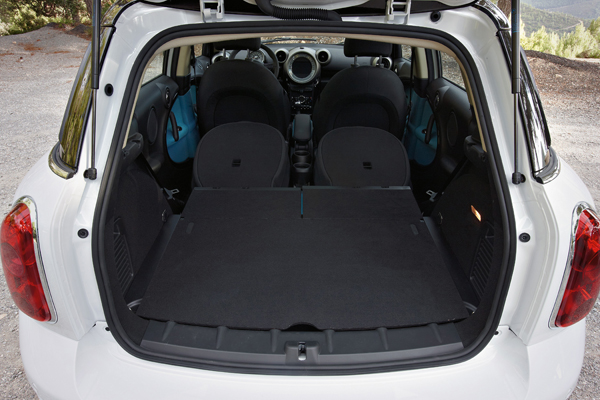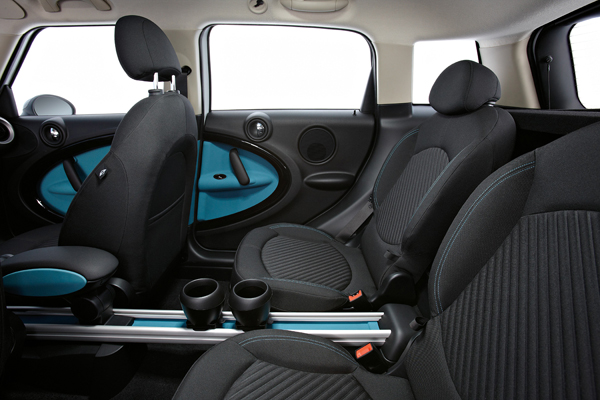I saw an original Mini the other day. And it looked tiny by modern compact car standards. But those diminutive dimensions were at the very core of what made the Mini a motoring icon. It was a triumph of clever packaging and innovative engineering. It was kind of cute, too.
Much of the Mini’s essence was expressed by the front-wheel drive layout, which placed the engine and transmission over the front axle, driving the front wheels. This configuration cost less to build, was more efficient, and freed up interior space. As it happened, it also allowed good traction, and offered benign, understeer-regulated handling. Since then, virtually all compact and subcompact cars have adopted a front-wheel drive layout. And even though cars seem to grow bigger and more complex with each successive generation, Sir Alec’s original, diminutive Mini remains the quintessential example of a compact city car.

By comparison, the modern Mini is big and, some would say, bloated. Yes, it exudes a certain cartoon-character cheekiness. And yes, it’s still compact, if more in relative than in absolute terms. But it lacks the economy of execution, the sparse elegance of the original Mini. What then if I told you that Mini’s latest creation is anything but mini – at least in dimensional terms. The Countryman is the largest Mini ever. It’s also the first Mini to offer an all-wheel drivetrain, and thus also becomes the first-ever Mini SUV.
If all of this sounds distinctly un-Mini (or is that Maxi), then you wouldn’t be the only one raising the proverbial eyebrow. Although the initial reactions to the Countryman have been cautiously favourable, one senses that even the famously patriotic British press is holding its collective breath – at least until the first full road tests have been completed. That prospect is still some way off for me: the Countryman won’t reach our shores until late this year. So, for now, let’s analyse the car’s concept, and try to ascertain just why Mini would want to build such a machine.
Since size counts, even in this compact car context, let’s consider the newcomer’s dimensions first. The Countryman is the first Mini to measure more than 4m in length. Raising the ride height has boosted overall height to 1,561mm. And at 1,791mm, it’s only just less than 1.8m wide. The result? An imposing, upscaled, Mini. A Mini maximised, in other words – at least as far as sheer, physical presence is concerned.

But the added bulk also raises some doubts. Will the Countryman retain the agility, the road-carving precision, and the emphatic dynamics that have become a key element of the Mini DNA? Will the raised ride height soften road manners, and increase the body roll? Mini says not. It’s equipped the Countryman with a bespoke suspension system designed to keep the car’s road responses crisp and lively. But the suspension’s longer travel has also allowed a softer, plusher ride – a move we suspect will please older, more comfort-orientated buyers.
Does that make the Countryman a Mini for the golden oldies? Well, I hope not. But it is clear that Mini is seeking to expand its brand appeal. And while even the current Mini has a distinctly youthful appeal, the promise of a more benign ride (and more interior space) could well attract a more mature audience.
Perhaps that audience will also buy into the promise of the Countryman’s enhanced versatility. The modern Mini, with its big wheels and low-profile rubber, barely manages to negotiate the potholed surface of SA’s suburban roads, let alone any gravel routes.The Countryman can be ordered with All4 – an all-wheel drive system that allows an electro-magnetic centre diff to vary the front/rear power split, depending on traction requirements. It won’t get you through the Richtersveld, but it will provide extra grip if and when you need it. Most of the time, All4 only drives the front wheels. But if things get slippery, up to 50% of the engine’s urge will find its way to the back wheels, ensuring better grip. And the system will even allow all the power to be sent to the rear axle.

My guess is very few Countryman buyers will opt for the All4 system – if they wanted a compact 4x4, they’d buy a real one. However, the raised ride height will certainly appeal to SA drivers, who generally like a commanding view of their surroundings. Besides, there’s something vaguely gung-ho about even quasi-4x4s that rings a welcome bell in the South African psyche.
The Countryman’s other selling point is space and practicality – concepts not particularly high on the current Mini buyer’s agenda, because it only has two doors, because rear accommodation is cramped, and because the boot is tiny. The Countryman neatly addresses all of those issues. It has four doors – one more even than the quirky but spacious Clubman. A large tailgate provides easy access to the boot, and the rear bench seat is split 40:20:40, which adds even more versatility. That bench seat can also be moved fore and aft to vary the amount of rear passenger legroom relative to cargo space. Nominal boot space comes to 350 litres, but there’s a whole 1,170 litres to play with once the bench seat is folded flat.

For now, Mini Countryman buyers have a choice of two drivetrains, both linking petrol powerplants to manual gearboxes. The Cooper Countryman is the base model, and uses a latest-generation 1.6 litre four-cylinder petrol engine with high-tech Valvetronic variable valve timing. It combines 90kW of power with 160Nm of torque – figures that will allow adequate performance at sea level, but may be considered a little anaemic at Johannesburg’s 1,600m altitude. Make full use of the Countryman’s extended luggage space, and expect the dynamics to be blunted further.
Not that the factory performance figures are that bad. The Cooper Countryman stops the clock at 10.5 sec for the 0-100 km/h dash, and manages a top speed of 190 km/h. But remember, these are ideal results at sea level: the on-road reality will almost certainly be slower.
The Cooper S version is more promising. I’ll admit to always liking the Cooper S as a tar-ripping alternative to more ostentatious performance machinery, and on paper, the Countryman version is likely to be the better pick. The addition of a twin-scroll turbocharger ups power to an impressive 135 kW, with accompanying torque topping out at 240 Nm – although another 20Nm can be coaxed from the four-potter for short periods using overboost.
The accompanying performance stats prove that power – and turbo power in particular – does translate into more oomph. The 0-100 km/h sprint is despatched in 7.6 sec, almost a full 3 sec quicker than the Cooper. And the top speed increases to a wicked 215 km/h. A surprisingly sophisticated suspension system allows the Countryman to conquer a variety of road conditions. An all-independent front set-up links MacPherson struts to coil springs and an anti-roll bar, but the real finesse comes from the multilink rear set-up.

That aside, the Countryman’s pedigree and heritage almost dictates an element of automotive fun and idiosyncrasy. It’s been part and parcel of the Mini personal from the outset, and the Countryman shares most of the key attributes: funky, oversized instrument dials, bright and contrasting colours, and high-grade finishes. While there is an extensive options list for each of the two models, standard equipment levels are comprehensive. CD sound, air-con, central locking, power steering and electric windows are standard fare. Options vary from iPod and Bluetooth interfaces to a panoramic glass sunroof, adaptive headlights, sport suspension and various performance upgrades.
The question is not whether the Countryman is a good car. That answer will be provided soon enough by the by the new car sales stats. What matters more is whether the Countryman is a good Mini. Unfortunately, Sir Alec is no longer around to give us his point of view – although I expect he would consider this latest Mini far too complex, too big, and too heavy to be considered an authentic Mini. But then, the automotive landscape is no longer the same, either.
For now, Mini is intent on expanding its model palette. But as demand for smaller, lighter, more efficient cars continues to grow, it may one day rue the decision to propel the brand upmarket. Meanwhile, we wait with bated breath for a first, real city car to make its electric bow. And we expect it to be small: about as small as the original Mini, perhaps?
By Deon Schoeman
deon@rpmtv.co.za




